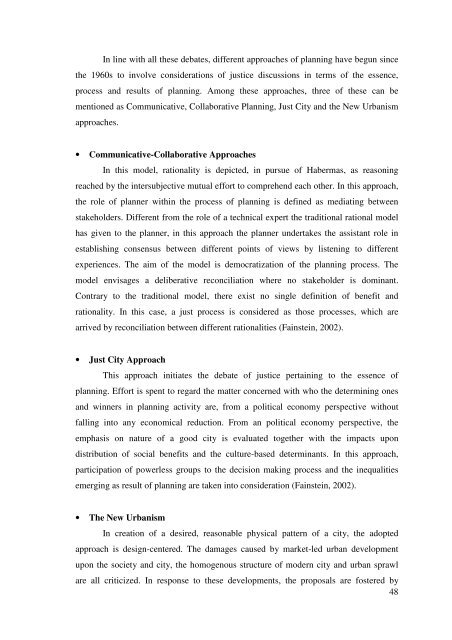a critical evaluation on the concept of justice in planning process
a critical evaluation on the concept of justice in planning process
a critical evaluation on the concept of justice in planning process
You also want an ePaper? Increase the reach of your titles
YUMPU automatically turns print PDFs into web optimized ePapers that Google loves.
In l<strong>in</strong>e with all <strong>the</strong>se debates, different approaches <strong>of</strong> plann<strong>in</strong>g have begun s<strong>in</strong>ce<br />
<strong>the</strong> 1960s to <strong>in</strong>volve c<strong>on</strong>siderati<strong>on</strong>s <strong>of</strong> <strong>justice</strong> discussi<strong>on</strong>s <strong>in</strong> terms <strong>of</strong> <strong>the</strong> essence,<br />
<strong>process</strong> and results <strong>of</strong> plann<strong>in</strong>g. Am<strong>on</strong>g <strong>the</strong>se approaches, three <strong>of</strong> <strong>the</strong>se can be<br />
menti<strong>on</strong>ed as Communicative, Collaborative Plann<strong>in</strong>g, Just City and <strong>the</strong> New Urbanism<br />
approaches.<br />
• Communicative-Collaborative Approaches<br />
In this model, rati<strong>on</strong>ality is depicted, <strong>in</strong> pursue <strong>of</strong> Habermas, as reas<strong>on</strong><strong>in</strong>g<br />
reached by <strong>the</strong> <strong>in</strong>tersubjective mutual effort to comprehend each o<strong>the</strong>r. In this approach,<br />
<strong>the</strong> role <strong>of</strong> planner with<strong>in</strong> <strong>the</strong> <strong>process</strong> <strong>of</strong> plann<strong>in</strong>g is def<strong>in</strong>ed as mediat<strong>in</strong>g between<br />
stakeholders. Different from <strong>the</strong> role <strong>of</strong> a technical expert <strong>the</strong> traditi<strong>on</strong>al rati<strong>on</strong>al model<br />
has given to <strong>the</strong> planner, <strong>in</strong> this approach <strong>the</strong> planner undertakes <strong>the</strong> assistant role <strong>in</strong><br />
establish<strong>in</strong>g c<strong>on</strong>sensus between different po<strong>in</strong>ts <strong>of</strong> views by listen<strong>in</strong>g to different<br />
experiences. The aim <strong>of</strong> <strong>the</strong> model is democratizati<strong>on</strong> <strong>of</strong> <strong>the</strong> plann<strong>in</strong>g <strong>process</strong>. The<br />
model envisages a deliberative rec<strong>on</strong>ciliati<strong>on</strong> where no stakeholder is dom<strong>in</strong>ant.<br />
C<strong>on</strong>trary to <strong>the</strong> traditi<strong>on</strong>al model, <strong>the</strong>re exist no s<strong>in</strong>gle def<strong>in</strong>iti<strong>on</strong> <strong>of</strong> benefit and<br />
rati<strong>on</strong>ality. In this case, a just <strong>process</strong> is c<strong>on</strong>sidered as those <strong>process</strong>es, which are<br />
arrived by rec<strong>on</strong>ciliati<strong>on</strong> between different rati<strong>on</strong>alities (Fa<strong>in</strong>ste<strong>in</strong>, 2002).<br />
• Just City Approach<br />
This approach <strong>in</strong>itiates <strong>the</strong> debate <strong>of</strong> <strong>justice</strong> perta<strong>in</strong><strong>in</strong>g to <strong>the</strong> essence <strong>of</strong><br />
plann<strong>in</strong>g. Effort is spent to regard <strong>the</strong> matter c<strong>on</strong>cerned with who <strong>the</strong> determ<strong>in</strong><strong>in</strong>g <strong>on</strong>es<br />
and w<strong>in</strong>ners <strong>in</strong> plann<strong>in</strong>g activity are, from a political ec<strong>on</strong>omy perspective without<br />
fall<strong>in</strong>g <strong>in</strong>to any ec<strong>on</strong>omical reducti<strong>on</strong>. From an political ec<strong>on</strong>omy perspective, <strong>the</strong><br />
emphasis <strong>on</strong> nature <strong>of</strong> a good city is evaluated toge<strong>the</strong>r with <strong>the</strong> impacts up<strong>on</strong><br />
distributi<strong>on</strong> <strong>of</strong> social benefits and <strong>the</strong> culture-based determ<strong>in</strong>ants. In this approach,<br />
participati<strong>on</strong> <strong>of</strong> powerless groups to <strong>the</strong> decisi<strong>on</strong> mak<strong>in</strong>g <strong>process</strong> and <strong>the</strong> <strong>in</strong>equalities<br />
emerg<strong>in</strong>g as result <strong>of</strong> plann<strong>in</strong>g are taken <strong>in</strong>to c<strong>on</strong>siderati<strong>on</strong> (Fa<strong>in</strong>ste<strong>in</strong>, 2002).<br />
• The New Urbanism<br />
In creati<strong>on</strong> <strong>of</strong> a desired, reas<strong>on</strong>able physical pattern <strong>of</strong> a city, <strong>the</strong> adopted<br />
approach is design-centered. The damages caused by market-led urban development<br />
up<strong>on</strong> <strong>the</strong> society and city, <strong>the</strong> homogenous structure <strong>of</strong> modern city and urban sprawl<br />
are all criticized. In resp<strong>on</strong>se to <strong>the</strong>se developments, <strong>the</strong> proposals are fostered by<br />
48
















